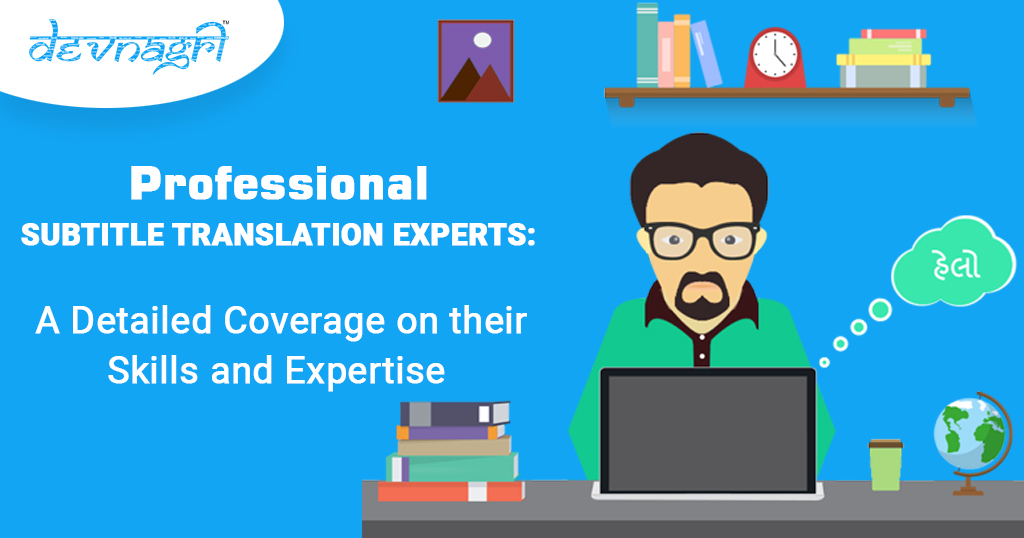
[:en]Communication is a basic necessity for any field of work, research, and education. We are living in a technologically-developed world, where good language skills are considered as the primary source of personality development. In specific, there are business sectors that focus on language and communication; one such booming field is that of subtitle translation.
- The translation process involves changing the language of content with accuracy.
- Subtitles are the captions that are displayed on-screen in a video.
Coming back to the point of business, many youngsters and freelance professionals are now predominantly seen in translation and subtitling jobs. However, to become a subtitling expert, it requires a heavy emphasis on language and communication skills. Beyond these two, there are many other aspects that make a subtitle translator standalone from the rest. Following below is the detailed coverage on the expertise, skills needed, and personality traits of subtitle transaction experts.
The Fundamental Job of a Subtitler
Subtitler is the designation given to someone who is into the work of adding translated captions (subtitles) for videos. Subtitlers are needed for media-related requirements such as movies, NetFlix, iTunes, Amazon Prime, YouTube, and even social media (SM) videos. Also, reputed voice-over translation services hire subtitlers for their in-house projects.
Note that the word ‘subtitler’ applies for both manual (human processed subtitling) and automated (machine-generated subtitles). So, to be more precise, let’s use the term translators or subtitle translators in this entire context. Hence, the primary role of a subtitle translating professional is to change the language of a video’s subtitles with precision and quality. Retaining the overall meaning of the translated version is an unsaid rule.
To avoid confusion, let’s also define transcription. Transcription is the process of converting media file formats (audio and video) into text (physical copies). The one who does this procedure is called a transcriber. People usually get confused with the terms ‘transcriber’ and ‘subtitler’ since both work with video and language conversions. Still, there is a major difference in the process of how a service is undertaken. As an added value, experienced transcribers are also asked to translate the final transcript, depending on the purpose!
The 2 Modes of Doing Subtitle Translation
We now know what a subtitle translator does. However, the process of doing a subtitle translation can be possibly done in two different way as given below;
- Interlingual: The first step is to transcribe the video. Then he or she will translate the content in the required target language and put the written words as subtitles below the video’s display.
- Intralingual: Similar to interlingual, but the translation step is not undertaken here. Meaning, first a video is transcribed and then the readable format (transcript) is uploaded directly within the video as subtitles.
So, whether someone needs a translated copy or not has to be instructed to the concerned subtitling expert beforehand. This also gives us the direct interpretation that all subtitles are not necessarily translated. But it also does not mean that the overall procedure is simple! The following description states how challenging the job of a subtitle translator is.
The Intricacies Present in Subtitling and Translation
First and foremost rule of translation (and subtitling) is to retain the original meaning of the context in the target language. Following this, accuracy also comes into play. Usually, experienced professionals manage to achieve a precision of about 98% in the project. Besides these, a subtitle translator should also:
- Spell the words correctly
- Understand the source and target language’s dialects and nuances.
- Must focus on displaying the subtitle for quite some time to avoid pressurizing the viewer to read fast.
- Be proficient in grammar.
- Check if the phrases or words included do not have any cultural-sensitivity issues.
Subtitle and its translation is hence a critical process and involves specific personality traits. And these traits are the keys, which help the professional to understand the audience’s language barrier!
A Professional Subtitle Translator has these 2 Personality Traits
The following three qualities can help identify a novice from a language specialist. They are also the traits that usually voice-over translation services expect from interview candidates.
- Time Management: When beginners try to translate the subtitles within the time limit, professionals tend to submit the project quite soon before the deadline. Subtitle translation also demands an expert to be punctual at his/her work station, and this is a significant point when it comes to live-broadcasting services.
- Language Expertise: Communication and language go hand-in-hand. Subtitling translators cannot compromise on their language, communication, presentation, and writing skills. With higher knowledge on these aspects, the person will give coherent subtitles and translated copies.
The success of a language professional can finally be noted when a hearing-disabled person or a non-native individual understands the subtitle and the translation! [:]





